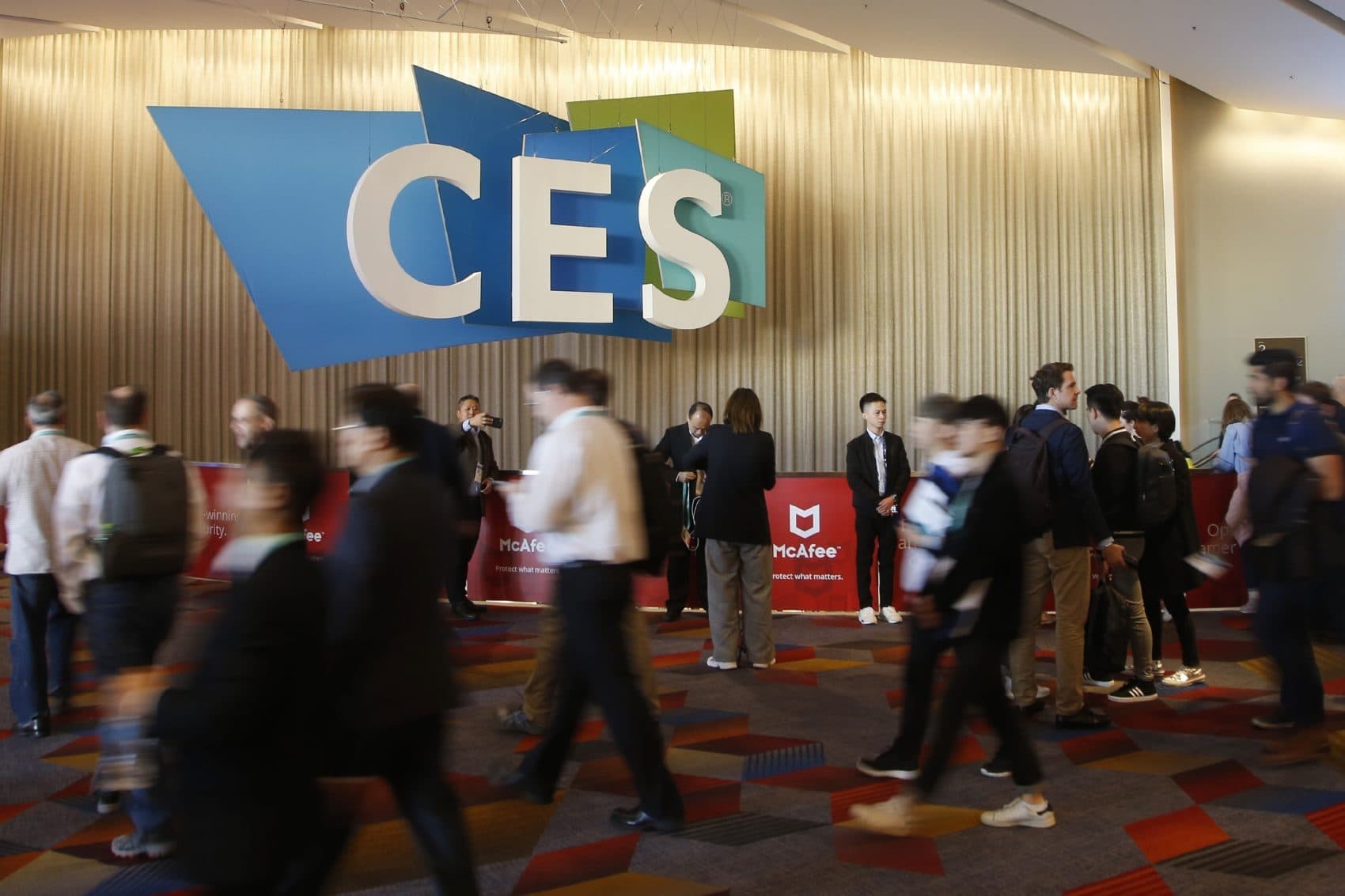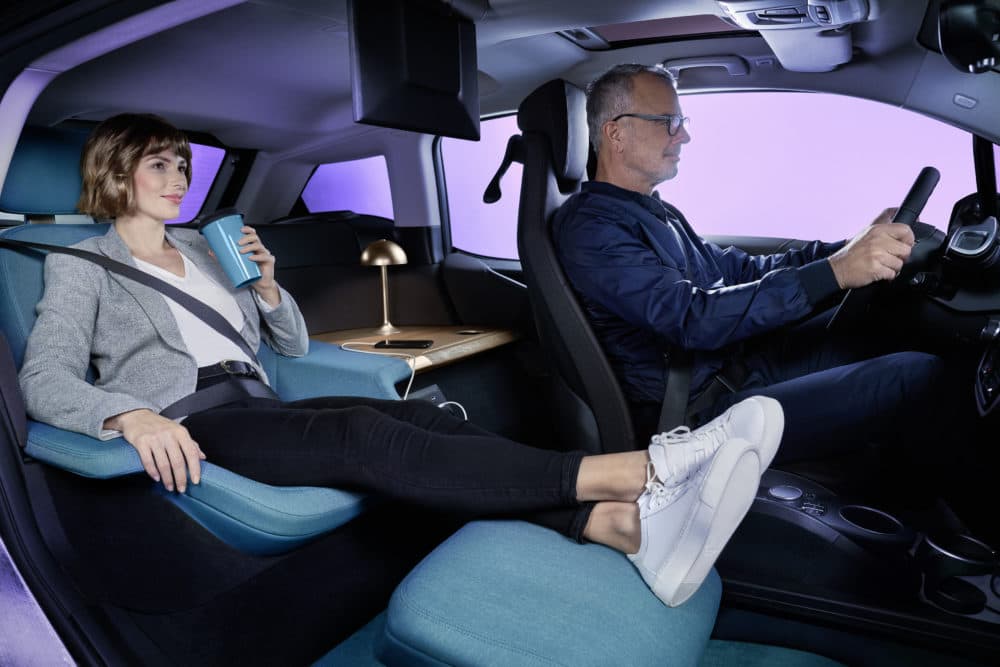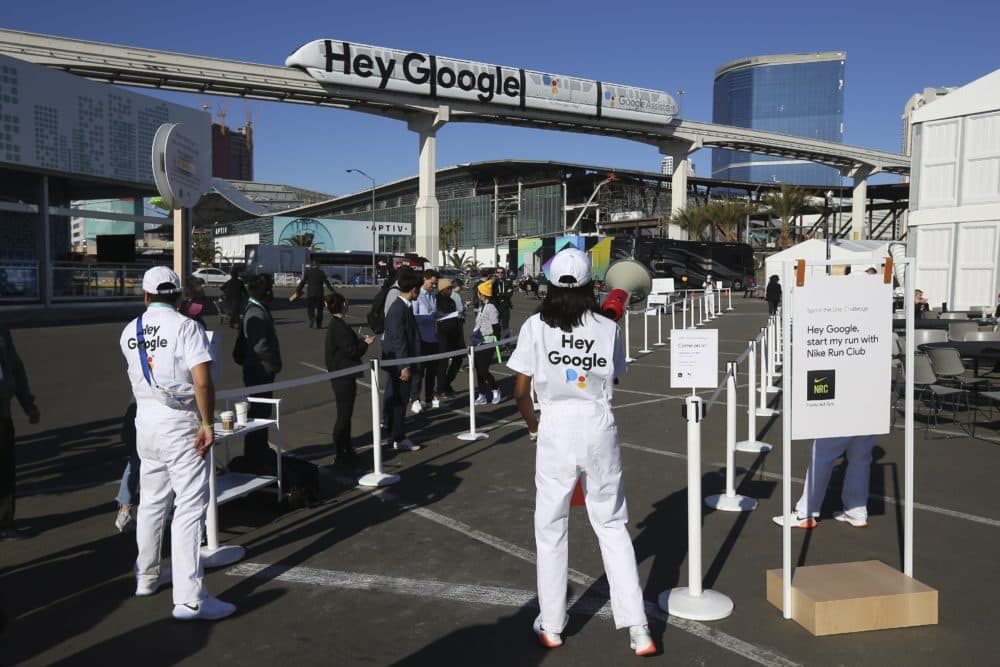Advertisement
A Pair Of Public Radio Station Nerds Went To CES (So You Didn't Have To)

Ever felt like a fish out of water? Try being a couple of public radio employees at a tech conference.
Although calling CES — the Consumer Electronics Show — a mere "tech conference" is an understatement. CES is a gargantuan, sprawling, completely overwhelming experience. We can try to describe it, but you really have to see it — and hear, feel, taste, touch it — to understand it. As its website boasts, CES features over 4,500 exhibits, more than 1,000 speakers and — this is not a typo — 175,000 people in attendance.
To compound the dizzying array of distractions, every vendor is doing whatever it takes to stand out. Have you checked out the toilet paper delivery robot? Or Toyota's planned city at the base of Mount Fuji? The brainwave-controlled prosthetic hand? What about the Alexa-enabled Lamborghini? Or the talking bathroom mirror that's your new BFF?
Did we mention the locale? Las Vegas! That's right, in case your head weren't already on a swivel, the world's most distracting city is also competing for your attention.
So, Why Did We Go To CES?
Project CITRUS is focused on improving the quality, quantity, discoverability and availability of WBUR's digital audio news. But that's just a smaller piece of the larger picture: helping public radio evolve to face the future.
We can't get a bead on the future of radio, however, if we don't know what the future — and, in particular, the future of technology — holds.
What Did We Learn?
In short, a lot. Weeks later, we're still processing it all.
But before we get into the details, a quick disclaimer: CES was immensely valuable. It injected us with a dose of excitement, awe and healthy apprehension about the connected, autonomous, tech-everywhere future we seem to be headed toward. That said, we realize that CES is replete with concept cars and vaporware; one should take it all with a grain (or more) of salt.
Emerging Car Tech Means Major Radio Disruption
- Will 2020 (finally) be the year? For years, the dream of frictionless, cutting-edge car infotainment systems has been dampened by a lack of coordination and cooperation across the industry. Slow sales, combined with a resistance to aftermarket technology, further compounded the bottleneck; the average car is nearly 12 years old. At the same time, this fact could also foretell a sharp increase in new car sales. Needless to say, slick new entertainment choices could spell the end of FM's dominance in the car, pushing radio toward an uncertain and disruptive future.
- Alexa in the car. Amazon was in full force at CES, displaying a wide variety of Alexa-enabled devices built specifically for the car. Most of them are aftermarket and still somewhat clunky: glued-on rather than built-in. This is still first-generation stuff, though the aforementioned Lamborghini certainly helped with the buzz.
- Looking beyond the driver. Another CES talking point: It's high time to focus on the "passenger economy." Ride-hailing services and autonomous cars are moving us toward a future where high-tech interiors look and function more like your living room, including all the screens and speakers and distractions you would expect. How does public radio gain a foothold here?

Voice Takes Another Leap
- Voice was everywhere. Just about every piece of hardware on the vast show floors was voice-enabled. The technology is becoming ubiquitous, from Instant Pots to toothbrushes to shower heads.
- Renewed focus for Google. The company's voice-assistant branding was everywhere — a huge outdoor venue with an ebullient hype team clad in white jumpsuits; sprawling billboards on the Vegas Strip; even a completely ad-wrapped Monorail. Scott Hoffman, who leads engineering for Google Assistant, emphasized the tech giant's voice prioritization in 2020 (Full disclosure: Project CITRUS is funded in part by the Google News Initiative and WBUR is a content partner with Google Assistant).
- The next paradigm? At the daylong VOICE Summit within CES, we heard over and over again — granted, from evangelists with a vested interest in the success of this technology — that voice is the next phase in digital interaction, as transformative as the explosion of the web or as huge as the evolution of mobile.
- Voice offers distinct advantages. For example, we can speak faster than we can type. One VOICE session used the Domino's Pizza phone app to demonstrate the time savings of making a complex pizza order via voice, instead of navigating the app's labyrinthine touch interface.
- Multimodality could be pivotal. Smart displays, which provide visual output to voice queries, are going to "change everything," Hoffman told attendees from the stage. Another speaker, WillowTree CEO Tobias Dengel, explained that while we can speak faster than we can type, we can read faster than we can listen. As a result, having a visual response to a voice command makes device interactions even more seamless.
- The rise of "ambient computing." This was another oft-repeated phrase: The belief that computing as we know it — a screen and a box and a keyboard — is slowly sinking into the background and allowing users to have a continuous, frictionless experience wherever they go. Voice will be the primary interface of that experience.

5G, 5G, 5G
- 5G was an omnipresent undercurrent. The much-hyped, fifth-generation wireless (after 4G, 3G, etc.) continues to wow people with ultrafast download speeds, low latency and potentially game-changing applications: autonomous vehicles, virtual reality and augmented reality, mobile gaming like Google Stadia and, yes, even remote surgery.
- Taking off the rose-colored glasses. There are significant drawbacks to 5G: it threatens to seriously burden the power grid; it is a hot geopolitical issue; it could further increase the digital divide. Moreover, there's a good deal of confusion about what 5G is and when it's going to go mainstream. All that said, bullish believers claim 2020 will be a pivotal year as consumer awareness grows and more infrastructure is built.
- What might 5G mean for news? To start, it could help facilitate fuller, more engaging and more innovative user experiences: smoother VR and AR storytelling, reliable and crisp live video feeds, dynamic and immersive web presentations and more. Until now, that type of work has been the domain of one-off experiments. Notably, WarnerMedia and The Washington Post have set up units specifically to explore applications of 5G; the former had a CES booth.
- 5G could make the reporting process even more efficient. Think of a reporter who needs to transmit huge video or image files from the field. In those breaking-news scenarios, information could get back to the newsroom, and then out to the public, almost instantaneously.
- A studio in your pocket? In a 5G-connected world, smartphone apps like Report-IT and WhatsApp could yield audio even closer to studio quality (less grainy, fewer cutouts, etc.) Simply put, a bigger, faster pipe could provide better sound in remote recording scenarios, as well as facilitate the speedy transfer of big .wav files. This could, in turn, free up valuable studio time and create more flexibility for audio producers.
- 5G could be disruptive for audio news specifically. With the rise of internet streaming, radio options have gone from a few dozen FM stations to thousands and thousands of choices. 5G increases the accessibility of those stations. But much more importantly, it also brings gigabytes of hitherto clunky, heavy, inaccessible content — slick 8K video and buffer-free Netflix, for instance — to your phone or tablet.
- A new frontier. Audio may face more competition as the ability to process visually stimulating content becomes faster, and available in traditionally audio-dominated environments — namely the car. In a fully autonomous vehicle, complete with a 5G connection and 48-inch screen, will a commuter still choose to listen to Morning Edition, or instead binge-watch "The Great British Baking Show"?
- There are a lot of unknown unknowns. If 5G connectivity allows a doctor in China to do brain surgery on a patient hundreds of miles away, who knows what could come next?
'Artificial' Intelligence Reframed As 'Augmented' Intelligence
- AI-powered virtual assistants are inching forward. The progress has been slow, and we're still very much in an era of clunky "conversations" between consumers and assistants like Alexa. The technology's current lack of precision and propensity for misunderstanding have led to a lot of frustration. That said, we're still at the beginning. One CES panelist spoke about how the tech allowing you to talk to your phone, or your watch, or a smart speaker — once the stuff of sci-fi, lest we forget — is still a "toddler."
- The next generation of AI interactions will be more proactive, personal and contextual — all with less friction. For example, you're driving and the gas tank is almost empty. Your in-car AI would proactively say, "You're about to pass the last gas station for 30 miles and you're running low on fuel. Would you like to pull over?"
- An "artificial human"? Samsung's project Neon was perhaps the splashiest AI debut at CES. As CNET reported: "Imagine if Siri or Alexa had a virtual face and could carry on a genuine conversation instead of only fetching you tomorrow's forecast." Neon was heavy on wow factor, but many felt the tech failed to deliver on its robust preshow hype campaign.
- AI's capacity to augment, rather than replace. Speakers were quick to assuage fears that AI will cause widespread job displacement. Applied to audio news, "augment" could mean using AI to transcribe, comb a massive dataset or even generate voice-cloned audio. Less time cutting tape and transcribing means more time for nuanced, critical thinking-heavy aspects of reporting that humans excel at: interviewing, editing, story structure, etc.
- AI can help us understand our users and personalize their experience. This was another overarching CES takeaway: We're just getting started when it comes to consumers' ability to leverage technology to configure and customize their lives to the nth degree — as long as they're willing to part with the requisite data.
- AI poses a threat to people's ability to discern what's true and what's not. Deepfakes have already introduced us to this reality. Worse, one could envision a scenario in which AI misuse creates so much disinformation that people distrust news altogether. Journalists obviously have a vital role to play in guarding against this.
Other Notable Trends
- Even more streaming services. Quibi, the "quick bite," mobile-video streaming service led by former Walt Disney Studios chairman Jeffrey Katzenberg and former HP executive Meg Whitman, hosted a headline keynote. Additionally, NBC's Peacock was fanning its feathers on the show floor. The industry continues to double-down on on-demand content.
- Wearables and now hearables. Keep an eye on small, discreet, lightweight devices: glasses, earbuds, watches. They are intended to slip into the background and augment your everyday experiences — the ambient computing model! Will people buy them? And actually use them? How can radio and news squeeze into this space?
- The rise of the thin client? Samsung debuted its new Sero TV, which works both in portrait and landscape mode. It is, in essence, a comically large smartphone. But this got us thinking. Is this a harbinger? Will every screen in the future — every TV, tablet and mirror — just be a big, dumb (albeit 8K) slab of glass? Powered, for the most part, by that super-powerful 5G phone in your pocket?
Further CES Reading
- "Your next car will probably connect to the internet. So will your TV and doorknobs. One day, you may even adopt a robot companion capable of analyzing its environment and reacting to your actions in real time." (New York Times)
- "One of the big themes at CES this year has been the race to own the media experience when cars go driverless." (Axios)
- "Lots of companies still tout AI like it's magic, but nobody is buying it. Companies still insist on mentioning AI in their press releases, but don't wait for you to ooh and ahh anymore." (The Verge)
- "2019 was a breakout year for Spotify's podcasting efforts, and now the company is turning up the dial on its ability to monetize this popular form of audio programming." (TechCrunch)
- "Smart home technology filled every corner of CES ... as companies competed to show off how their designs would improve people's home life in ways large and small beyond the growing variety of smart speakers and smart displays available to buy." (Voicebot.ai)
- "After six annual trips to CES, it is now fairly easy to conclude that fantasy is easy and integration is hard. It's one thing to imagine the future, and so much of that is the fun of attending CES, but creating, building and implementing something of value to consumers is often elusive." (Amplifi Media)

